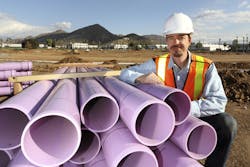EPA provides additional funds for water and wastewater projects in California
CARLSBAD, Calif. — Jan. 27, 2016 — California will receive more than $182 million in federal funding to support statewide improvements in local drinking water and wastewater infrastructure and to reduce water pollution, according to a press release.
Some of the funds are expected to go towards San Francisco’s planned Lake Merced Green Infrastructure Project, which will install stormwater management features, such as bioretention planters and linear vegetation strips adjacent to the curb, in a dense residential setting within a disadvantaged area of the city, noted the release.
Another project will enable the City of Davis to change the source of its drinking water from groundwater to the Sacramento River by connecting to a new regional water treatment facility, stated the release. This will reduce the amount of selenium in the local drinking water and also help Davis meet the requirements of its wastewater discharge permit, the U.S. Environmental Protection Agency (EPA) said.
EPA Regional Administrator Jared Blumenfeld announced the additional funding on Wednesday at an event highlighting a $37 million investment in the Carlsbad Water Recycling Facility. The expansion of the facility will nearly double its capacity to generate water for nonpotable uses like irrigation and industrial use, reported the release.
The City of Carlsbad is using approximately $30 million through a one percent interest State Revolving Fund loan and an additional $7 million in other funding to expand its water recycling capacity from 4,100 acre-feet per year to 7,235 acre-feet per year, shared the release. The project includes 18 miles of pipe, a new storage tank and 156 new recycled water meters.
Once the work is completed, Carlsbad will recycle and use all of its wastewater during the summer months, meeting nearly 33 percent of its water district’s annual water needs.
You can find the entire release here.
